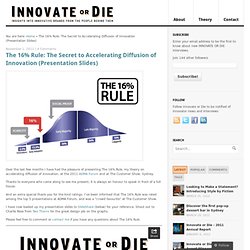

Influence the Psychology of Persuasion Book Summary. Influence: The Psychology of Persuasion (Collins Business Essentials) (9780061241895): Robert B. Cialdini. The 16% Rule: The Secret to Accelerating Diffusion of Innovation (Presentation Slides) Over the last few months I have had the pleasure of presenting The 16% Rule, my theory on accelerating diffusion of innovation, at the 2011 ADMA Forum and at The Customer Show, Sydney.

Thanks to everyone who came along to see me present, it is always an honour to speak in front of a full house. And an extra special thank you for the kind ratings. I’ve been informed that The 16% Rule was rated among the top 5 presentations at ADMA Forum, and was a “crowd favourite” at The Customer Show. I have now loaded up my presentation slides to SlideShare (below) for your reference. Shout out to Charlie Rose from Two Thorns for the great design job on the graphs. Please feel free to comment or contact me if you have any questions about The 16% Rule. The Secret to Accelerating Diffusion of Innovation: The 16% Rule Explained | INNOVATE OR DIE (innovateordie.com.au) Like this: Like Loading...
Diffusion of innovations. The diffusion of innovations according to Rogers.

With successive groups of consumers adopting the new technology (shown in blue), its market share (yellow) will eventually reach the saturation level. In mathematics, the yellow curve is known as the logistic function. The curve is broken into sections of adopters. History[edit] The concept of diffusion was first studied by the French sociologist Gabriel Tarde in late 19th century[3] and by German and Austrian anthropologists such as Friedrich Ratzel and Leo Frobenius.[4] The study of diffusion of innovations took off in the subfield of rural sociology in the midwestern United States in the 1920s and 1930s. In 1962 Everett Rogers, a professor of rural sociology, published his seminal work: Diffusion of Innovations.
Elements[edit] The key elements in diffusion research are: Characteristics of innovations[edit] Studies have explored many characteristics of innovations. Characteristics of individual adopters[edit] Process[edit] Decisions[edit] Relevance paradox. The relevance paradox describes an attempt to gather information relevant to a decision, which fails because the elimination of information perceived as distracting or unnecessary and thus detrimental to making an optimal decision, can also inadvertently exclude information that is actually crucial.[1] Definition[edit] In many cases in which action or decision is required, it is obvious what information relevant to the matter at hand may be lacking: a military attack may not have maps so reconnaissance is undertaken, an engineering project may not have ground condition details, and these will be ascertained, a public health program will require a survey of which illnesses are prevalent, and so on.

However, in many significant instances across a wide range of areas, even when relevant information is readily available, the decision makers are not aware of its relevance because they lack the information which would make its relevance clear. Examples[edit] Avoidance[edit] See also[edit]